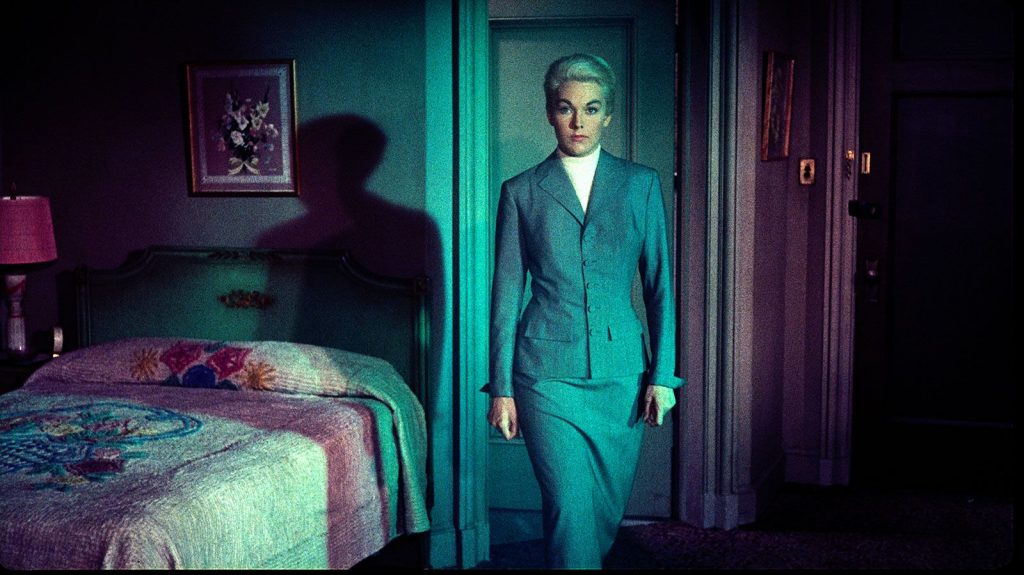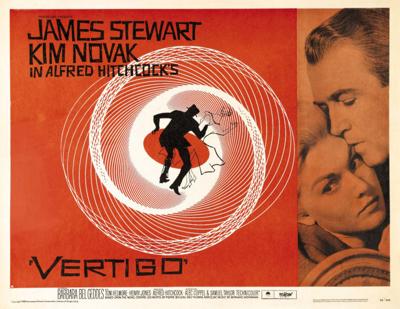by David Marler
Alfred Hitchcock’s 1958 Vertigo is on nearly every list of the best films of all time. It is not only an exciting story of a former detective who follows a suicidal woman around San Francisco, it is also an example of the basics of good cinematography. For this reason, the film is widely studied at colleges and universities across the world. And that is why my colleagues and I have chosen to use this film as one of the classics that we will examine with our students in a 100-minute workshop.
Synopsis
The film revolves are two main characters: former detective John “Scottie” Ferguson (played by James Stewart) who quits the police force after having a bout of fear of heights or vertigo, and Madeline Elster (played by Kim Novak) who believes that she is really a dead relative from the 19th century: Carlotta Valdes (1831-1857). There are also two supporting characters: Marjorie “Midge” Wood (played by Barbara Bel Geddes) who doubles as Scottie’s female best friend and Gavin Elster (played by Tom Helmore) who pays Scottie to follow his wife, who he believes has been possessed.
The film begins when we learn why Scottie has to quit the police. He is in pursuit and nearly falls off of the ledge of a building. A fellow officer dies, and in the next scene we learn that Scottie suffers from vertigo: dizziness when confronted with heights. A college friend, Gavin Elster, hires Scottie to follow his wife around. Elster believes that his wife, Madeline, has been possessed by a dead relative, Carlotta Valdes, who killed herself at the age of 28.
Scottie follows Madeline around and begins to believe that she has indeed become possessed by Carlotta. Scottie follows her to various landmark places in San Francisco: the San Francisco Legion of Honor (a museum) where Madeline stares at a painting of Carlotta Valdes, the Mission San Francisco de Asís where Madeline stares blankly at Carlotta’s grave, and finally Fort Point under the Golden Gate Bridge where Madeline attempts suicide. Scottie falls in love with Madeline, but their affair is short-lived when Madeline commits suicide by jumping off the tower of the Mission San Juan Bautista; Scottie is unable to intercede and stop the suicide, as his fear of heights keeps him from climbing the stairs of the steeple. Scottie becomes wrought with grief over Madeline’s suicide – he is committed to a mental health hospital and becomes catatonic and unresponsive.
Months after Scottie’s recovery, he runs into the young Judy Barton, who looks a lot like Carlotta, save her hair color and dress. Scottie buys her new clothes and forces her to wear them. This visibly upsets the young girl from Salina, Kansas. We learn through a letter she planned to give to Scottie (but did not) that she was hired by Elster to act as his wife so he could kill his wife in a staged suicide that was actually a murder.
In the end, Judy slips up and wears a necklace that was Madeline’s (and Carlotta’s). It is then that Scottie takes Judy to the San Juan Bautista Mission, and forces her up the stairs of the steeple. She confesses her role in the real Madeline Elster’s murder and then commits suicide when a nun comes up the stairs.

Workshop (100 minutes)
Part 1: Knowledge of the film
Activity 1: Setting in cinematography (20 minutes)
Hitchcock’s Vertigo can almost be seen as an ode to San Francisco. For this opening activity, each group will be given an important place in San Francisco that was in the film. Your group will have 5 minutes to prepare answers the following questions:
- What happened at this place? (What was its significance for the plot?)
- What feeling does the viewer get during the scene?
Group 1: the San Francisco Legion of Honor
Group 2: Mission San Francisco de Asís
Group 3: Fort Point
Group 4: Muir Woods
Group 5: Mission San Juan Bautista
After they have discussed their setting/scene, they will share them with the group.
Activity 2: Group discussion (25 minutes)
- What feelings does the viewer experience throughout the film? How does Hitchcock achieve this?
- Film critics have argued that Vertigo is a film about the male-gaze, about seeing and being seen. Do you agree? Where can we see this the most in the film?
- What role does Midge play in the film? What are her feelings towards Scottie, and Scottie’s feelings towards her? Why don’t they ever foster a relationship?
- What is the viewer supposed to feel about Scottie and his obsession with Judy’s looks, how she dresses, how she does her hair? Is it feminist or misogynistic of Hitchcock to put this in the film?
- In Judy’s apartment (before she writes the letter), the viewer does not know whether Judy and Madeline are the same person. How does Hitchcock do this (cinematographically) and why?
- Why do you think Judy commits suicide in the end?
Part 2: Knowledge of style, genre, and theme
Activity 3: Lecture on Hitchcock and the Psychological Thriller (30 minutes)
The lecture will begin with a short introduction to Alfred Hitchcock – who is seen as one of Britain’s most prolific directors and filmmakers.
The lecture will then focus on genre and technique. Hitchcock’s Vertigo is the quintessential psychological thriller. For this lecture, the students must understand the following key term:
Psychological thriller (genre): “The psychological thriller is a subgenre of thriller that explores the psychology of its characters, who are often unstable. What makes a thriller psychological is that the biggest questions revolve around the minds and behavior. Psychological thrillers often incorporate elements of mystery and include themes of crime, morality, mental illness, substance abuse, multiple realities or a dissolving sense of reality, and unreliable narrators.” (Source: Master class)
Finally, we will focus on film technique and analyze a few sections of the film. We will look at the following techniques and scenes:
- Point-of-view (cinematographic term): “Point of view (POV) is a variation of eye-line match. The two are similar, in that a character looks offscreen and we see where he or she is looking. With POV, however, the audience is, in effect, looking through the character’s eye.” (Source: The Columbia Film Language Glossary).
For point-of-view we will examine the “First sighting” scene where we are introduced to Madeline. Notice how the scene is shot from our point-of-view. Look at how we walk into the restaurant and then we look at Scottie and see him gaze at Madeline and then we focus on Madeline and then we too look at her as she walks towards us to leave the restaurant.
Class discussion: What effect does this point-of-view have on the viewer? What emotions does it elicit?
2. The close-up (cinematographic term): “A close-up is a shot in which a person’s face fills most of the screen, although the term can also refer to any shot that appears to have been taken at close range (or through a telephoto lens), and in which an object appears relatively large and in detail.” (Source: The Columbia Film Language Glossary)
For the close-up we will look at the introduction.
Class discussion: What is the significance of this introduction? Why do you think Hitchcock used it? How can it be tied into some of the movie’s themes?
3. Lighting and filter (cinematographic term): This is the way a director uses light and color to change an object in the film.
For this part of the lecture we will look at the clip of Judy becoming Madeline:
Class discussion: How does Hitchcock use light to introduce Madeline back to us? What effect does this have on the viewer?
4. Camera angle (cinematographic term): “Camera angle refers to where the camera is placed in relation to the subject of the image. In general, the camera is placed approximately at eye level, or up to six feet off the ground.” (Source: The Columbia Film Language Glossary)
5. Rule of thirds (cinematographic term): “The rule of thirds is a concept in video and film production in which the frame is divided into into nine imaginary sections, as illustrated on the right. This creates reference points which act as guides for framing the image. Points (or lines) of interest should occur at 1/3 or 2/3 of the way up (or across) the frame, rather than in the centre. Like many rules of framing, this is not always necessary (or desirable) but it is one of those rules you should understand well before you break it.” (Source: Media College)
For these two terms we will look at Scottie saving Madeline as she attempts to commit suicide under the Golden Gate Bridge.
Class discussion: Why do directors use the rule of thirds and what effect does it have on us as viewers?
Activity 4: The best film ever? (25 minutes)
Many critics, including the British Film Institute, have called Vertigo the best film of all times. Before class, students were asked to read “Forever falling: what makes Vertigo great” by Miguel Marías for the British Film Institute (2019). For this 20-minute activity, the students will work in short groups to compile a list of reasons Marías believes that Vertigo is the greatest film of all times, and they will also be asked to add two of their own (if they agree), or two counterarguments (if they disagree). In short, the instructions are:
-Discuss Marías’s article “Forever falling: what makes Vertigo great” and compile a list of at least five arguments he has for why Vertigo is the greatest film of all time.
-Add two of your own examples is you agree, or two counterarguments (or examples) if you disagree.
-You will have 10-15 minutes to discuss, the last 10 minutes will be used to share our answers.
